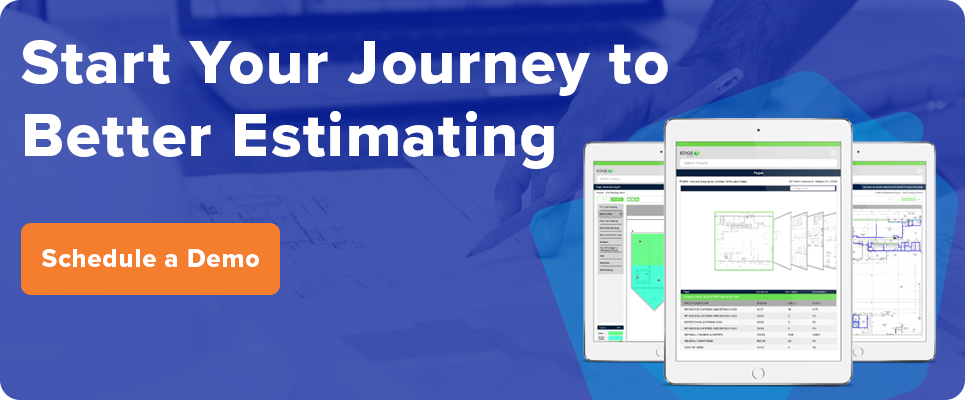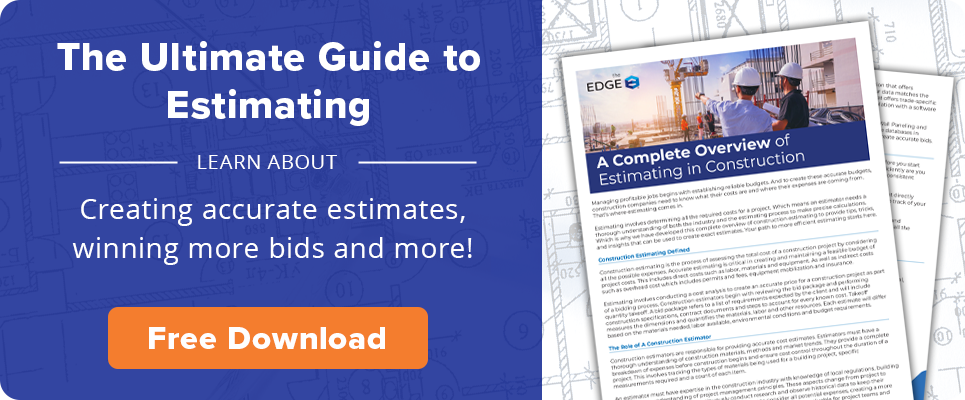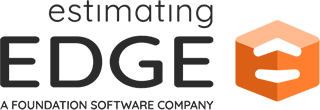
What is construction takeoff software?
Construction takeoff software helps contractors automate material calculations and streamline project bidding. A takeoff is a crucial element of the success of almost any construction company’s bidding process.
Conducting a takeoff is one of the initial steps in a construction bid proposal. That’s why takeoff software is so important.
By automating manual takeoff calculations, construction takeoff software can save contractors and builders significant time and money.

Construction Takeoff: An In-Depth Definition
A construction takeoff, also known as a material takeoff or quantity takeoff, calculates the materials needed for a construction project. This essential process involves analyzing the blueprint to determine the types and quantity of materials required for each part of the project.
Construction takeoffs can look different for every project, but in general, they always include lists of the materials and assemblies needed to complete the job, along with each item’s dimensions and quantities.
Every estimator must know exactly what materials and quantities are needed to complete the job successfully.
The construction takeoff serves as an essential step in the construction process, helping contractors accurately estimate the amount of materials required for the project. The takeoff can be done manually or with the help of specialized software.
Manual takeoffs for commercial construction used to take hours, depending on the project size. Armed with blueprints, a pencil, a ruler and a calculator, the estimator completed the work manually. Measuring walls, windows, doors and flooring and counting every aspect of the job was tedious, often resulting in human error.
Construction takeoff software improves accuracy — no more missed or transposed numbers creating incorrect data.
What’s not included in construction takeoff
While a construction takeoff typically includes detailed lists of resources and costs, some items may not be included, such as:
- Permits and Fees: Costs associated with obtaining permits, inspections, and other regulatory requirements may not be included in a construction takeoff.
- Design and Engineering: Costs associated with design and engineering services may not be included in a construction takeoff, as a separate team may perform these services.
- Land Acquisition: Costs associated with acquiring land for the construction project may not be included in a construction takeoff.
- Legal Fees: Costs associated with legal services such as contract review, dispute resolution, and litigation may not be included in a construction takeoff.
- Contingency Funds: Contingency funds, typically set aside to cover unforeseen expenses or changes in the scope of work, may not be included in a construction takeoff.
Overall, a construction takeoff provides a detailed estimate of the materials, labor, equipment, and costs associated with a construction project, but there may be additional costs that are not included in the takeoff and should be considered by the contractor.
Why Accuracy Matters in Construction Takeoffs
A construction takeoff forms the foundation of project cost estimating, influencing both budget accuracy and bid competitiveness. Construction takeoff software is designed to eliminate the costly errors that plague manual estimation processes.
If the takeoff is inaccurate, it can result in significant financial losses, missed deadlines and potential legal disputes. Overestimating the materials and labor can make a project uncompetitive, while underestimating can result in cost overruns, delays and the potential for a failed project.
Therefore, ensuring the takeoff is as accurate as possible is crucial. By prioritizing accuracy in the takeoff process, construction companies can ensure a realistic and competitive cost estimate for their projects, reducing the risk of financial losses and project failure.
How Construction Takeoff Software Integrates With Estimating
While takeoff is the first step in creating a proposal, the process becomes even more powerful when integrated with construction estimating software.
This combination helps construction professionals calculate both material quantities and the associated costs for labor and materials required to complete a construction project.
Integrated takeoff and estimating solutions streamline labor cost calculation, enhance job reporting and create seamless workflows from initial measurement through final bid submission.
It may also include:
- Components for change order tracking
- Bid management
- Data report editing
Using integrated construction takeoff and estimating software can help reduce errors, improve the accuracy of cost estimates, save time and improve efficiency. It can also help construction professionals manage their projects more effectively by providing real-time pricing updates.
Key Features of Modern Takeoff Solutions
Selecting the takeoff solution that best fits your company’s needs is an important process. There are several features to consider when making this decision.
Cloud-Based Access and Mobility
Modern construction takeoff software provides cloud-based access, meaning consistent updates and quick technology access from anywhere. This accessibility is crucial in today’s mobile construction environment, where estimators need to review plans and make adjustments from various locations such as:
- Jobsites
- Client meetings
- Home offices
Cloud-based solutions eliminate the need for expensive software installations and ensure your team always has access to the latest features and security updates.
Cloud-Based Document Storage and Management
A cloud-based system easily saves and stores all necessary documents. This means no more shuffling through paperwork, as everything is accessible from any device.
This centralized approach dramatically reduces the risk of lost documents and ensures version control, meaning everyone works from the most current plans and specifications.
Cloud storage also provides automatic backups, protecting your valuable project data from hardware failures or disasters.
Customizable Templates and Smart Assemblies
Customizable templates and innovative assemblies that save within the system equate to less work on future projects. These pre-built components allow estimators to quickly apply standard configurations for common construction elements like:
- Wall assemblies
- Roofing systems
- Electrical layouts
This feature significantly reduces repetitive work and ensures consistency across similar projects, leading to more accurate bids and faster turnaround times.
Exportable Breakout Reports
Breakout reports that can be exported to share with the accounting team, contractors, field teams and owners provide essential project transparency.
These detailed reports break down material quantities and costs by trade or project phase. In turn, this enables better project management and cost control.
Stakeholders can easily understand where money is being allocated and make informed decisions about project modifications or value engineering opportunities.
Advanced Search and Filter Capabilities
A filter and search space to find information quickly and easily becomes invaluable as projects grow in complexity.
Modern takeoff platforms handle thousands of line items. Additionally, the ability to instantly locate specific materials, assemblies or cost categories saves hours of manual searching.
This feature is particularly important during the bidding phase when time is limited and accuracy is critical.
The Digital Takeoff Process: How Modern Solutions Work
When running a takeoff, the estimator loads the blueprint into the software. The system can pull a list of required materials and prefabricated items from its comprehensive database. Using the calculations done by the software, the quantity and measurement needed for each item are determined.
The construction takeoff is then moved to the estimating part of the software. This portion must also be automatically uploaded to avoid any mistakes in the entry. The estimating software takes the data and draws from its pre-populated supplier pricing lists to calculate material costs.
What are the Potential Challenges of a Construction Takeoff?
The biggest challenge of takeoff is accurate counting. Commercial construction projects are typically more extensive, and a slight miscalculation often leads to a significant difference in pricing.
That is why construction takeoff platforms are the best way to go. If you are using quality software meant for construction, counting is automated. The blueprints are simply loaded into the software; the rest is done for you.
5 Benefits of Using Construction Takeoff Software
To create job-winning bids, contractors need accurate takeoff – which is where takeoff software comes in. Five advantages of construction takeoff software include:
Save Time and Get Quicker Results
Shave 40-70% off of takeoff and estimate time by using software that provides a combination of effort-saving items like prefabricated components and recurring items that save time on similar job bidding.
Boost Efficiency & Productivity
Eliminate costly errors and meet deadlines for bidding. Takeoff software reduces human error by automating complex calculations and providing consistent, repeatable processes.
This increased accuracy means fewer change orders and better project outcomes, while faster turnaround times allow contractors to bid on more projects.
Facilitate Improved Collaboration
Construction takeoff software allows for real-time collaboration, enabling team members to work together on the same project simultaneously. This improves communication and reduces the risk of errors caused by miscommunication.
Team members can access the same files from different locations, make updates in real-time and maintain version control across all project stakeholders.
Send Precise Bids
Rest assured that your bid is precise and doesn’t contain over- or under-bidding.
Advanced takeoff software uses precise measurements and calculations to ensure accuracy, reducing the risk of costly estimation errors. This precision leads to more competitive bids that accurately reflect project costs, improving win rates and profit margins.
Obtain a Competitive Edge
With intelligent templates and a professional bidding process, construction takeoff and estimating software give companies a competitive edge.
The ability to quickly generate detailed, professional proposals sets contractors apart from competitors still using manual methods. Faster turnaround times also allow contractors to respond to more opportunities and build stronger client relationships.

Final Thoughts on Construction Takeoff Software!
Set yourself up for success by automating the takeoff process. Spend more time winning bids and less time measuring!
Estimating Edge offers industry-specific takeoff and estimating software. Our team of expert construction professionals designed our system just for you! With over 30 years of experience, let us help you streamline your processes.
Request a demo: (844) 334-3378





